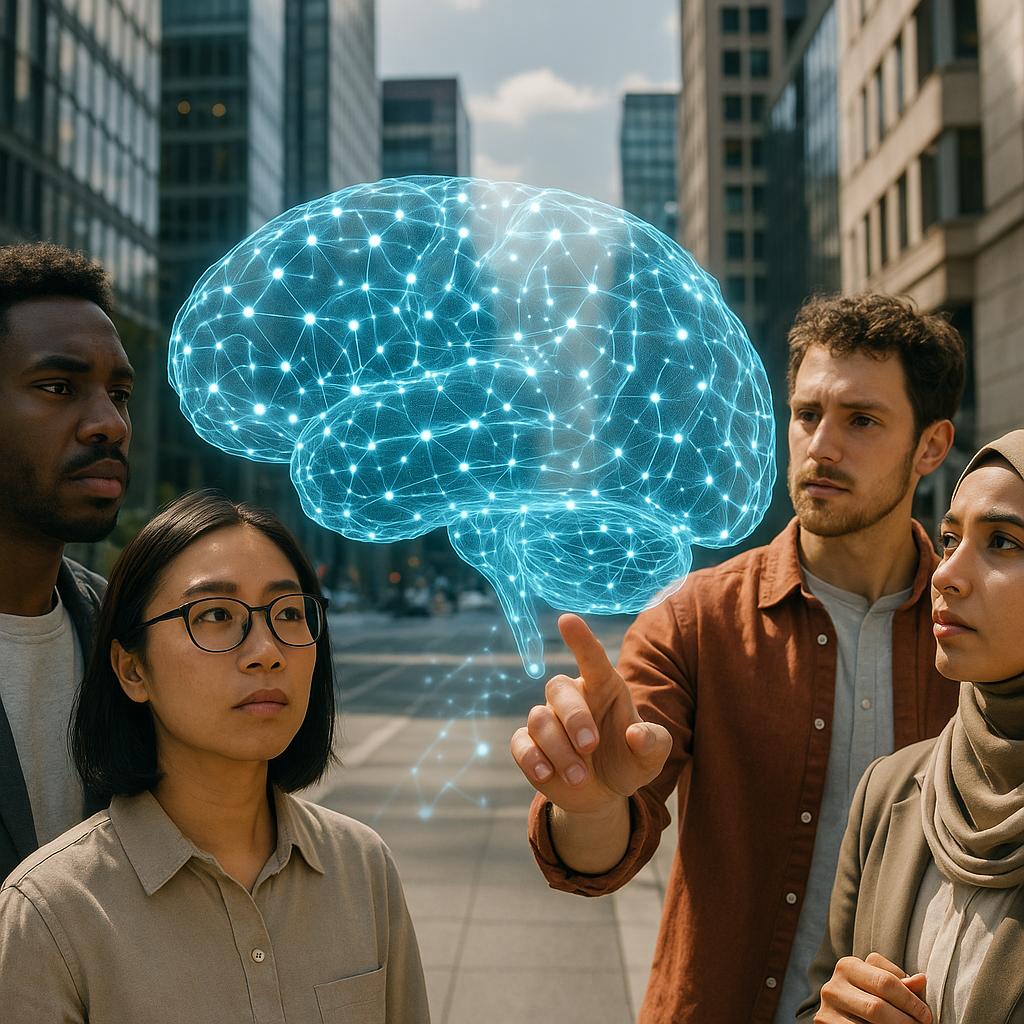Many people see AI only as new technology, but sociologists pay attention to the broader picture.
AI influences and is influenced by human behavior, institutions, and culture. When people use AI, they shape its development and how it is applied. In turn, AI changes how people connect, work, and make decisions.
This back-and-forth relationship means AI is never just a tool. It becomes part of daily routines, social norms, and power structures. For these reasons, sociology studies AI to understand its real-world impacts on communities and society as a whole.
Sociologists examine AI for its power to reinforce or disrupt patterns like inequality, surveillance, and public trust. They ask questions like these:
- Who designs AI systems, and for whom?
- How do communities respond to automated decisions?
- What new rules or norms appear as AI becomes common?
- Which jobs or skills change or disappear with AI tools?
- Are new forms of inequality showing up in healthcare, policing, or education due to AI?
AI and Social Structure: A Systems-Level View
AI reshapes how big institutions work together. Structural-functionalism and systems theory show these changes pop up at all levels, not just where software or robots sit.
For example:
- In education, AI recommends lessons to students and changes who receives extra support.
- Hospitals use algorithms for patient triage, which affects who receives care first.
- Courts might use risk scores to guide bail or parole decisions and shape outcomes in subtle ways.
Social order sometimes grows more stable when AI handles routine paperwork. By automating tasks, structural-functionalism suggests that institutions become more efficient, reinforcing existing routines.
Other times, key human roles shrink or vanish, which may cause confusion or stress. This disruption can weaken traditional social norms and authority structures, especially as trust and power shift to automated programs.
In other words, AI can both reproduce and disrupt social order within complex institutional systems.
AI and Social Inequality
AI frequently mirrors social divides already out there. Bias can slip in at many stages. For instance, the data used to train AI may reflect past discrimination, and incorporate inequalities right into the system.
Code and design choices might ignore minority voices. Researchers found facial recognition more likely to misidentify people of color, contributing to racially skewed outcomes. Hiring tools sometimes favor applicants who fit old workplace trends, privileging men or majority groups, as noted in one research.
In healthcare, some AI tools predict less care for poorer patients. In education, school algorithms may steer resources toward students in wealthier areas.
From a conflict theory perspective, AI can reinforce class structures by maintaining status quo advantages for those with more resources. According to critical sociology, those with less access to new tech or quality data, marginalized by class, race, or gender, see fewer benefits.
These patterns underline how AI, unless critically examined, risks deepening social inequality.
Surveillance, Identity, and Control in the Digital Age
AI makes monitoring easier and more widespread. Automated cameras track movement in public spaces, while social media platforms use AI to review posts and spot patterns.
Companies and governments apply tools that sort, rank, or flag people, sometimes without their knowledge. This kind of “invisible watch” aligns with Michel Foucault’s panopticon concept – individuals self-regulate their behavior due to the mere possibility of constant surveilance, even in the absence of actual observation. Surveys show that majority of adults in U.S. express discomfort with extensive digital tracking.
AI fundamentally shapes how people present themselves online, echoing Goffman’s theory of self-presentation. Platforms suggest content or connections, nudging users to curate their profiles in desirable ways. AI-driven practices ripple through daily life and reshape personal identities.
Over time, people may adjust what they share or highlight online to fit the expectations or trends suggested by these AI systems, sometimes leading to a gap between their real selves and their digital image.

Work, Labor, and Automation: A Sociological Reframing
Some tasks shrink or disappear because AI now handle them. This forces some workers to retrain or move into roles that did not exist a decade ago. Not to mention the ongoing debate about AI “stealing” many jobs.
Sociologist Harry Braverman wrote about “deskilling,” where tools reduce the need for specialized knowledge. His deskilling thesis suggests that automation erodes worker autonomy and transforms skilled labor into routine, monitored tasks. Many workers now face greater precarity (less security about long-term employment) as automation spreads.
Labor force surveys show that nearly half of workers worry about machines taking over their jobs. While new jobs sometimes appear, they often lack the same pay or stability.
Examples include:
- Warehouse staff tracking robots instead of picking items
- Customer support shifting to chatbots, which cuts entry-level roles
- Truck drivers facing self-driving vehicles taking over some routes
Reskilling helps, but not everyone has access or time to learn new skills quickly.
Cultural Narratives: Public Attitudes and the Myth of AI
People usually picture AI as either a miracle worker set to solve every problem or a threat that could spiral out of control. These views are shaped through ongoing interaction and shared symbols (media images, movie plots, and public debates) that give meaning to what AI represents in society.
According to symbolic interactionism, individuals interpret AI through cultural cues, leading to collective myths of either utopian innovation or dystopian collapse.
Generally, people have mixed feelings:
- Curiosity and anxiety coexist about machines making decisions.
- Older adults tend to worry more about job loss, while younger people express concerns about privacy.
Media coverage, especially science fiction, fuels narratives of robot takeovers or sudden rebellion. This persistent storytelling from media studies helps explain why many imagine technology as either saving or endangering society.
Final Thoughts: Toward Ethical and Democratic AI
Sociologists push for AI development that includes a wider range of voices in decision-making. When ordinary people, not just engineers or executives, take part in designing systems, the results show more fairness and accountability.
Recent projects use participatory workshops, inviting community groups to discuss their needs. This gives groups most affected by algorithms a real say. Some cities set up data ethics committees or citizen panels to check how AI tools work and spot unintended problems early.
Taking a sociological perspective encourages AI systems that are more accountable and inclusive, highlighting the need for ongoing dialogue, iterative feedback, and shared ethical standards.
Liked this article? Try Stryng for free. It’s the AI platform that helped write it. You can also contact the Stryng team if you need great content for your marketing.



